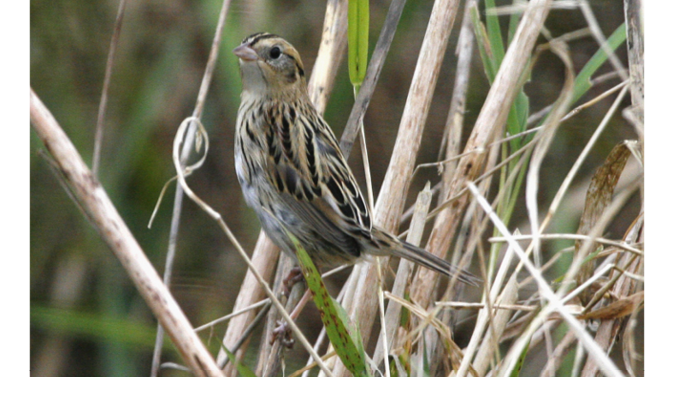Wayne R. Petersen

WAYNE R. PETERSEN
This issue’s At a Glance image appears to be a sparrow. You know the look: it is streaky and has a conical bill, and—in the color image online—it is generally brownish in color. Also, it is perched in a grassy or weedy habitat. Are we ready to explore sparrow possibilities? No, not yet. Why isn’t the mystery bird a female Bobolink instead of a sparrow? A Bobolink is certainly a grassland possibility.
The reason the mystery species cannot possibly be a Bobolink is that its bill is way too small, its legs are far too slim, and the overall structure of the bird is way too delicate to belong to a blackbird. Otherwise, the mystery species bears a superficial resemblance to an immature, an adult female, or a male Bobolink in nonbreeding plumage. A Bobolink also exhibits coarser streaking on both its back and its sides, usually appears more yellowish on the underparts, exhibits less pattern on the nape, and has a more pointy-tipped tail.
Having established that the mystery species is indeed a sparrow and not a Bobolink, we can concentrate on its features: the broad, unmarked supercilium (eyebrow stripe) above the eye; the thin, pale median crown stripe just visible above the base of the bill; the grayish lores between the eye and the base of the bill; the thin dark stripes on the sides of the breast and on the sides and flanks; and the prominent white edges to the tertials. In the color photograph, note also the buffy tone to the supercilium and the gray auriculars (cheek area).
This combination of features at once eliminates any of the sparrow species having unstreaked underparts. The overall delicate aspect and fine-streaked appearance also remove the chunkier and more heavily streaked Fox Sparrow and Song Sparrow as considerations. The broad, unmarked eyebrow stripe, absence of an eye ring, and absence of an obvious necklace of streaks take the Savannah and Vesper sparrows off the table. What is left are five species of grassland or marshland sparrow: Grasshopper in the genus Ammodramus, Henslow’s in the genus Centronyx, and LeConte’s, Nelson’s, and Saltmarsh—all in the genus Ammospiza. These species are small, often somewhat colorful, typically difficult to observe, and possess rather insignificant songs.
The Grasshopper Sparrow is not a candidate for identification because even the youngest Grasshopper is unlikely to show the extent of side streaking of the pictured sparrow, and normally exhibits an eye ring—a feature not visible in the pictured sparrow. Grasshopper Sparrows also have a noticeably heavier bill than the decidedly small bill shown by the mystery sparrow. A Henslow’s Sparrow also has a heavier bill, may also show an eye ring, displays two prominent dark spots at the rear of the ear coverts, and has an overall darker-headed—olive green—appearance. This leaves only the LeConte’s Sparrow and the two sharp-tailed sparrows as possibilities.
Both the Nelson’s Sparrow and the Saltmarsh Sparrow have solid crowns that are unmarked by a pale median stripe like the crown of the mystery sparrow. In addition, both of these species typically have a rather colorful orange triangle surrounding their gray cheek—a feature visible even in a black-and-white image. Accordingly, the combination of a pale median crown stripe, a small bill, and the absence of an orangish triangle-shaped border around the cheek and face of the mystery bird identifies it as a LeConte’s Sparrow (Ammospiza leconteii).
LeConte’s Sparrows are rare fall migrants in Massachusetts that occasionally linger into early winter, often but not exclusively near the coast. The species seems to prefer moist weedy or grassy fields, as well as the edges of salt marshes during migration, especially if there is dense vegetation at the periphery for hiding. The author photographed this LeConte’s Sparrow in the Cumberland Farms fields in Middleborough, Plymouth County, Massachusetts, on October 21, 2009.
Wayne R. Petersen